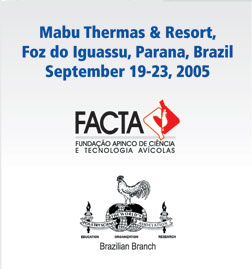Contributed Papers: Oral Presentations
Chemotherapy |
Coccidiosis
control in poultry: importance of the quality of anticoccidial
premixes
Maarten De Gussem
Janssen Animal Health
mdgussem@janbe.jnj.com
In commercial
poultry production, coccidiosis control is mainly
achieved by supplementing feed with chemical anticoccidials
such as diclazuril (Clinacoxâ), and ionophore
anticoccidials. Resistance is encountered when products
(chemicals and ionophores) are overused. Producers
carefully consider the balance in using the few anticoccidials
available by implementation of rotation, full and/or
shuttle programmes.
Because of a
strong coccidiocidal effect against all sensitive
parasites, chemicals like diclazuril reduce the coccidiosis
infection pressure. Generally, stronger coccidiocidal
effects result in faster resistance. Since many sensitive
parasites escape the action of ionophores, resistance
is induced more slowly.
On the other hand, ionophore mode-of-action (interference
with ion pumps, essential cell organelles in both
parasite and host) explains narrow safety margins
for some ionophores. Depending on the field conditions,
it is common to treat feed with lower than the most
effective dose, optimizing the balance between cost,
efficacy and toxicity.
There is no
reason to lower diclazuril doses, since the safety
margin is at least 20 times the recommended dose of
1 ppm. Moreover, it is crucial to maintain this 1
ppm of diclazuril: next to reduced coccidiosis control,
suboptimal dosing has shown to induce diclazuril-resistance.
Additives are
usually formulated as simple-mixtures or granulated
premixes. Although concept and quality of any anticoccidial
are crucial, when mixing at 1ppm diclazuril (the lowest
anticoccidial dose on the market), a more sophisticated
approach is required. A vacuum-coating production
technique, combined with use of strong but porous
particles as carrier, assures that diclazuril in Clinacoxâ
remains firmly attached to the carrier. Clinacoxâ
0.5%, mixed in at 200 g/ton, therefore provides excellent
mixing and minimal segregation, guaranteeing a maximal
number of birds receiving the right dose.
A recent
survey of 702 samples from Clinacoxâ treated
feed from mills worldwide showed that 86.47% of the
samples contained diclazuril levels over 0.8 ppm.
Samples were sent for a routine check of the mixability
of Clinacoxâor when poor quality of mill infrastructure
was suspected. Therefore, the results are likely biased
towards lower inclusion levels than generally encountered.
Anyhow, conclusions drawn from this survey are that
· a large majority of feed treated with Clinacoxâ
is within standards, and
· the development of special vacuum-coated
premix for anticoccidials, dosed at very low levels,
is crucial in maintaining both good coccidial control
and in avoiding resistance problems.
